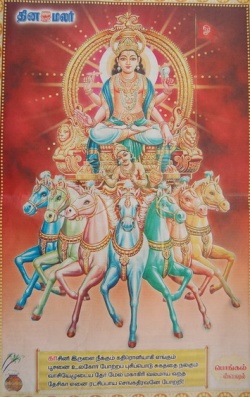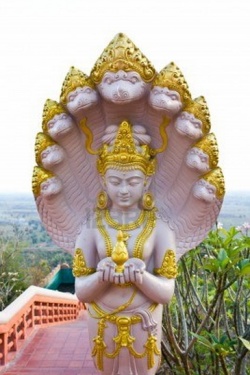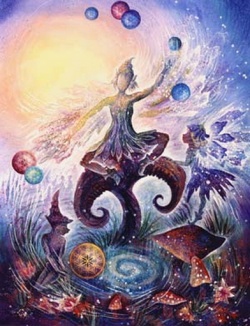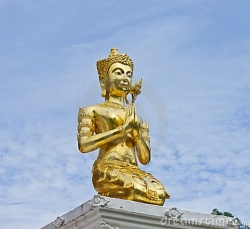Deva
A deva (देव Sanskrit and Pāli) in Buddhism is one of many different types of non-human beings who share the characteristics of being more powerful, longer-lived, and, in general, living more contentedly than the average human being. An inhabitant of the heavenly realms, which is characterized by long life, joyous surroundings and blissful states of mind. In the Buddhist tradition, these states are understood to be impermanent, not eternal.
Literally, "A shining one".
An inhabitant of the heavenly realms, which is characterized by long life, joyous surroundings and blissful states of mind. However, these states are impermanent, not eternal. Devas are still unenlightened, bound to Samsara and subject to Birth and Death. Many such beings have already been converted to Buddhism and become its protectors.
Synonyms in other languages include Khmer tep (ទេព), or preah (ព្រះ), Myanmar Language nat, Tibetan lha, Mongolian tenger (тэнгэр), Chinese tiān (天), Korean cheon, Japanese ten, Vietnamese thiên, Thai Thevada .The concept of devas was adopted in Japan partly because of the similarity to the Shinto's concept of kami.
Other words used in Buddhist texts to refer to similar supernatural beings are devatā "deity" and devaputra (Pāli: devaputta) "son of the gods". It is unclear what the distinction between these terms is.
Powers of the devas
From a human perspective, devas share the characteristic of being invisible to the physical human eye. The presence of a deva can be detected by those humans who have opened the divyacakṣus (Pāli: dibbacakkhu), an extrasensory Power by which one can see beings from other planes. Their voices can also be heard by those who have cultivated divyaśrotra, a similar Power of the ear.
Most devas are also capable of constructing illusory forms by which they can manifest themselves to the beings of lower worlds; higher and lower devas even have to do this between each other.
Devas do not require the same kind of sustenance as humans do, although the lower kinds do eat and drink. The higher sorts of deva shine with their own intrinsic luminosity.
Devas are also capable of moving great distances speedily and of flying through the air, although the lower devas sometimes accomplish this through magical aids such as a flying chariot.
Types of deva
The term deva does not refer to a natural class of beings, but is defined anthropocentrically to include all those beings more powerful or more blissful than humans. It includes some very different types of being; these types can be ranked hierarchically. The lowest classes of these beings are closer in their nature to human beings than to the higher classes of deva.
The devas fall into three classes depending upon which of the three dhātus, or "realms" of the Universe they are born in.
The devas of the Ārūpyadhātu have no physical Form or location, and they dwell in Meditation on formless subjects. They achieve this by attaining advanced meditational levels in another Life. They do not interact with the rest of the Universe.
The devas of the Rūpadhātu have physical forms, but are sexless and passionless. They live in a large number of "heavens" or deva-worlds that rise, layer on layer, above the earth. These can be divided into five main groups:
The Śuddhāvāsa devas are the rebirths of Anāgāmins, Buddhist religious practitioners who died just short of attaining the state of Arhat (Brahma Sahampati, who appealed to the newly Enlightened Buddha to teach, was an Anagami from a previous Buddha ). They guard and protect Buddhism on earth, and will pass into Enlightenment as Arhats when they pass away from the Śuddhāvāsa worlds. The highest of these worlds is called Akaniṣṭha.
The Bṛhatphala devas remain in the tranquil state attained in the fourth Dhyāna.
The Śubhakṛtsna devas rest in the bliss of the third Dhyāna.
The Ābhāsvara devas enjoy the delights of the second Dhyāna.
The Brahmā devas (or simply Brahmās) participate in the more active joys of the first Dhyāna. They are also more interested in and involved with the World below than any of the higher devas, and sometimes intervene with advice and counsel.
Each of these groups of deva-worlds contains different grades of devas, but all of those within a single group are able to interact and communicate with each other. On the other hand, the lower groups have no direct Knowledge of even the existence of the higher types of deva at all. For this reason, some of the Brahmās have become proud, imagining themselves as the creators of their own worlds and of all the worlds below them (because they came into existence before those worlds began to exist).
The devas of the Kāmadhātu have physical forms similar to, but larger than, those of humans. They lead the same sort of lives that humans do, though they are longer-lived and generally more content; indeed sometimes they are immersed in pleasures. This is the realm that Māra has greatest influence over.
The higher devas of the Kāmadhātu live in four heavens that float in the air, leaving them free from contact with the strife of the lower World. They are:
The Parinirmita-vaśavartin devas, luxurious devas to whom Māra belongs;
The Nirmāṇarati devas;
The Tuṣita devas, among whom the future Maitreya lives;
The Yāma devas.
The lower devas of the Kāmadhātu live on different parts of the mountain at the center of the World, Sumeru. They are even more passionate than the higher devas, and do not simply enjoy themselves but also engage in strife and fighting. They are:
The Trāyastriṃśa devas, who live on the peak of Sumeru and are something like the Olympian gods. Their ruler is Śakra.
The Cāturmahārājikakāyika devas, who include the martial kings who guard the four quarters of the Earth. The chief of these kings is Vaiśravaṇa, but all are ultimately accountable to Śakra. They also include four types of earthly demigod or nature-spirit: Kumbhāṇḍas, Gandharvas, Nāgas and Yakṣas, and probably also the Garuḍas.
"Furthermore, you should recollect the devas: 'There are the devas of the Four Great Kings, the devas of the Thirty-three,..." [196. Dh.] "Feeders of Joy we shall be like the radiant gods (devas)."
Sometimes included among the devas, and sometimes placed in a different category, are the Asuras, the opponents of the preceding two groups of devas, whose nature is to be continually engaged in War.
Humans are said to have originally had many of the powers of the devas: not requiring Food, the ability to fly through the air, and shining by their own Light. Over time they began to eat solid foods, their bodies became coarser and their powers disappeared.
There is also a humanistic definition of 'deva' [[[Wikipedia:male|male]]] and 'devi' [[[Wikipedia:female|female]]] ascribed to Gotama Buddha: a God is a Moral person. This is comparable to another definition, i.e. that 'Hell' is a name for painful emotions.
Devas vs. gods
Although the word deva is generally translated "God" (or, very occasionally, "angel") in English, Buddhist devas differ from the "gods" and "angels" of most religions past and present in many important ways.
Buddhist devas are not immortal. They live for very long but finite periods of time, ranging from thousands to (at least) billions of years. When they pass away, they are reborn as some other sort of being, perhaps a different type of deva, perhaps a human or something beyond comprehension.
Buddhist devas do not create or shape the World. They come into existence based upon their past karmas and they are as much subject to the natural laws of cause and effect as any other being in the Universe. They also have no role in the periodic dissolutions of worlds.
Buddhist devas are not incarnations of a few archetypal deities or manifestations of a God. Nor are they merely symbols. They are considered to be, like humans, distinct individuals with their own personalities and paths in Life. Devas however, have an immanent Buddha nature, as also do humans.
Buddhist devas are not omniscient. Their Knowledge is inferior to that of a fully Enlightened Buddha, and they especially lack awareness of beings in worlds higher than their own. It should be noted that some Buddhas resemble devas in the fact that they also inhabit celestial planes (or pure lands).
Buddhist devas are not omnipotent. Their powers tend to be limited to their own worlds, and they rarely intervene in human affairs. When they do, it is generally by way of quiet advice rather than by physical intervention.
Buddhist devas are not morally perfect. The devas of the worlds of the Rūpadhātu do lack human passions and desires, but some of them are capable of Ignorance, arrogance and pride. The devas of the lower worlds of the Kāmadhātu experience the same kind of passions that humans do, including (in the lowest of these worlds), lust, jealousy, and Anger. It is, indeed, their imperfections in the Mental and Moral realms that cause them to be reborn in these worlds.
Buddhist devas are not to be considered as equal to a Buddhist Refuge. While some individuals among the devas may be beings of great Moral authority and prestige and thus deserving of a high degree of respect (in some cases, even being Enlightened practitioners of the Dharma), no deva can ultimately be taken as the way of escape from Saṃsāra or control one's Rebirth. The highest honors are reserved to the Three Jewels of Buddha, Dharma, and Saṅgha.
Confused with devas
Mahayana and Vajrayana Meditation and practice includes several types of being that are often called "gods", but are distinct from the devas.
Bodhisattvas: A Bodhisattva may be a deva in a particular Life, but bodhisattvas are not essentially devas, and if they happen to be devas it is only in the course of being born in many different worlds over time. A Bodhisattva is as likely to be born as a human or as an animal, and is only distinguished from other beings by the certainty that eventually, after many lives, the Bodhisattva will be reborn as a Buddha. For example, the current Bodhisattva of the Tuṣita Heaven is now a deva. In his next Life, however, he will be reborn as a human – The Buddha Maitreya. Advanced Bodhisattvas are also capable of manifesting themselves in a great variety of forms (e.g. Avalokiteshvara as depicted in the Universal Door chapter of the Lotus Sutra), including the forms of devas, depending upon the circumstances. Also, bodhisattvas are classified higher than a deva.
Yidams: These meditational deities sometimes take the Form of ordinary devas and sometimes appear as manifestations of bodhisattvas, but they are in all cases to be taken as nondual manifestations of Enlightenment, with which the meditator intends to unite.
Buddhas: A Nirmāṇakāya Buddha (physically manifesting Buddha) is classified higher than a deva so Buddha is not a deva, as the right conditions for attaining supreme Enlightenment do not exist in the deva-worlds. A Sambhogakāya Buddha has the Form of a very high ranking deva, but does not exist within the Universe, subject to birth and Death, as all the devas do. The Cosmic Dharmakāya is beyond all worlds and limitations.
From Palikanon.com
(lit: the Radiant Ones; related to Lat. deus): heavenly beings, deities, celestials, are beings who live in happy worlds, and who, as a rule, are invisible to the human eye.
They are subject, however, just like all human and other beings, to ever-repeated Rebirth, old age and Death, and thus are not freed from the cycle of existence and from misery. There are many classes of heavenly beings.
I. The 6 classes of heavenly beings of the sensuous sphere (kāmāvacara or Kāma-Loka; s. Avacara Loka), are
- Cātumahārājika-deva,
- Tāvatimsa,
- Yāma,
- Tusita (s. Bodhisatta),
- Nimmāna-rati,
- Paranimmita-vasavatti. Cf. Anussati. (6).
II. The heavenly beings of the fine-material sphere (rūpāvacara or rūpaloka) are:
- Brahma-pārisajja, Brahma-purohita, Mahā-brahmāno (s. brahma-kāyika-deva). Amongst these 3 classes will be reborn those with a weak, medium or full experience of the 1st absorption (Jhāna, q.v.).
- Parittābha, Appamānābha, ābhassara. Here will be reborn those with experience of the 2nd absorption.
- Paritta-subha, Appamāna-subha, Subha-kinna (or kinha). Here will be reborn those with experience of the 3rd absorption.
- Vehapphala, Asañña-satta (q.v.), Suddhāvāsa (q.v.; further s. Anāgāmi). Amongst the first 2 classes will be reborn those with experience of the 4th absorption, but amongst the 3rd class only Anāgāmis (q.v.).
III. The 4 grades of heavenly beings of the immaterial sphere (arūpāvacara or arūpa-Loka) are:
- the heavenly beings of the sphere of unbounded space (ākāsānañcāyatanūpaga-devā),
- of unbounded Consciousness (Viññāna ñcāyatanūpaga-deva),
- of nothingness (ākiñcaññāyatanūpaga devā),
- of neither-Perception-nor- non-Perception (nevasaññā-nāsaññāyatanūpaga-devā). Here will be reborn those with experience of the 4 immaterial spheres (arūpāyatana; s. Jhāna 5-8).
See Gods and the Universe by Francis Story (Wheel 180/181).




